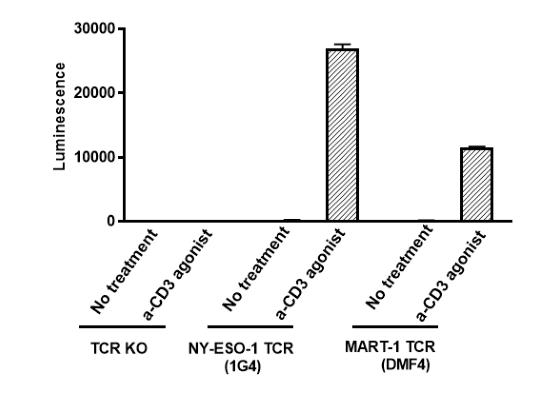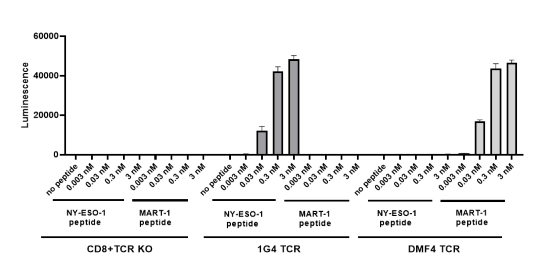CD8+ TCR Knockout NFAT-Luciferase Reporter Jurkat Cell Line
This cell line was generated from TCR Knockout NFAT Luciferase Reporter Jurkat Cell Line (BPS Bioscience #78556) by exogeneous overexpression of human CD8 (NM_001768.6) using lentiviral transduction (CD8a Lentivirus, BPS Bioscience #78648). To achieve knockout of TCR (T Cell Receptor), the TRAC (T-Cell Receptor Alpha Constant) and TRBC1 (T-Cell Receptor Beta Constant 1) domains of the TCRα/β chains were genetically removed by CRISPR/Cas9 genome editing from recombinant Jurkat cells stably expressing the firefly luciferase gene under the control of NFAT response elements.
TCRα/β knockout in the TCR Knockout NFAT-Luciferase Reporter Jurkat cells was confirmed by genomic sequencing and by flow cytometry and expression of CD8 was confirmed by flow cytometry. The cell line has been functionally validated and does not respond to anti-CD3 agonist antibodies, as opposed to parental NFAT-Luciferase Reporter Jurkat cells (BPS Bioscience #60621).
Purchase of this cell line is for research purposes only; commercial use requires a separate license. View the full terms and conditions.
| Name | Ordering Information |
| Thaw Medium 2 | BPS Bioscience #60184 |
| Growth Medium 2C | BPS Bioscience #79592 |
| Assay Medium 2D | BPS Bioscience #78755 |
| TCR KO NFAT Luciferase Reporter Jurkat Cell Line | BPS Bioscience #78556 |
| Anti-CD3 Agonist Antibody | BPS Bioscience #71274 |
| NY-ESO-1 Specific TCR Lentivirus (1G4) | BPS Bioscience #78675 |
| MART-1 Specific TCR Lentivirus (DMF4) | BPS Bioscience #78678 |
| T2 Cell Line | ATCC #CRL-1992 |
| NY-ESO-1 (157-165) Peptide | BPS Bioscience #78758 |
| MART-1 (Leu26-35, Leu27) Peptide | BPS Bioscience #78760 |
| APC MHC I Dextramer (HLA-A*02:01 SLLMWITQV) | Immudex #WB03247 |
| APC MHC I Dextramer (HLA-A*02:01 ELAGIGILTV) | Immudex #WB02162 |
| Alexa Fluor 647™ Anti-human CD8 | Biolegend #344725 |
| ONE-Step™ Luciferase Assay System | BPS Bioscience #60690 |
| 96-well tissue culture plate, white, clear bottom |
The cell line has been screened to confirm the absence of Mycoplasma species.
The TCR (T Cell Receptor) protein complex is found on the surface of T cells and is responsible for recognizing antigens bound to MHC (Major Histocompatibility Complex) molecules. Stimulation of the TCR results in activation of downstream NFAT (Nuclear factor of Activated T-cells) signaling. NFAT is a family of transcription factors that has an important function in immune responses, for example by inducing the expression of various cytokines (such as interleukin-2 to 4, and TNF-alpha) in T cells. NFAT is regulated by Ca2+ and the Ca2+/calmodulin-dependent serine phosphatase calcineurin.
The TCR consists of a heterodimer of two different protein chains, of which the alpha (α) and beta (β) chains are the predominant chains. CRISPR/Cas9 genome editing was used to remove the TRAC (T-Cell Receptor Alpha Constant) and TRBC1 (T-Cell Receptor Beta Constant 1) regions of the α and β chains, resulting in loss of TCR .





